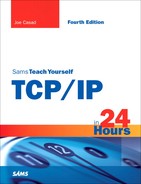Email Readers
An email reader is a client application that runs on a user’s workstation and communicates with an email server. As you learned earlier in this hour, the local workstation does not form a direct connection with the recipient of an email message. Instead, the workstation sends the message to an email server using an email reader. The server sends the message on to the email server assigned to the recipient. In a conventional email scenario, the user who will receive the message accesses a personal mailbox on the email server, and the message is downloaded to the user’s workstation. The first step and the last step in this process (sending the message to the original server and downloading the message from the receiving server) are typically performed by an email reader application.
The email reader serves three functions:
Sends outgoing messages to an outgoing email server using SMTP
Collects incoming email messages from an email server using POP3 or IMAP
Serves as a user interface for reading, managing, and composing mail messages
The email reader must be capable of serving as both an SMTP client and a mail retrieval (POP or IMAP) client.
The email protocols discussed earlier in this hour provide a clear roadmap for electronic mail communication and, for that reason, email readers are all similar. The details of how to configure an email reader may vary but, if you are familiar with the processes described in this hour, it usually isn’t difficult to figure out how to get it working. Like other network client applications, an email reader communicates with the network through the protocol stack. The computer with the email reader must have a working TCP/IP implementation, and it must be configured so that the email application can reach the network through TCP/IP.
After you have established that your computer is functioning properly as a client on a TCP/IP network, you need to obtain a few additional parameters from an official of your network to configure an email reader on your system. If you are a home user, obtain this information through your ISP. If you are a corporate user, obtain this information from your network administrator.
You need to know the following:
The fully qualified domain name of the email server to use for outgoing mail. This server often receives the hostname SMTP followed by the domain name (for example, SMTP.rosbud.org).
The fully qualified hostname of the POP or IMAP server.
The username and password of an email user account on the POP or IMAP server.
The task of configuring an email reader is largely a matter of obtaining these parameters and entering them into the email reader application.
Email reader applications have gradually become integrated into the standard desktop environment for most operating systems. Windows users access mail through the Windows Mail or Outlook mail client. Apple Mail is standard on Mac OS X systems. Linux systems typically come with a popular open source mail client such as Evolution or Mozilla Thunderbird.
Email readers are often integrated with other related tools that offer calendar, scheduling, and address book features. Mail readers can also interpret filename extensions (.doc, .txt, .pdf, .jpg) and launch the appropriate viewer application to read incoming attachments. This kind of integration with other applications is convenient if used appropriately, but it has also spawned a whole new generation of macro viruses—mostly affecting Windows systems—delivered through email attachments. A typical macro virus might access the user’s address book to learn new email addresses and then automatically email itself to the other users in the address book (see Figure 18.4).
By the Way
These types of viruses have caused considerable damage in the past, although the problem has gotten more manageable in recent years due to better public awareness and effective antivirus techniques. The important point is that accepting attachments and clicking on links delivered through email creates a risk for your system. Consult your OS vendor documentation for recommendations on how to configure your system to minimize that risk.

